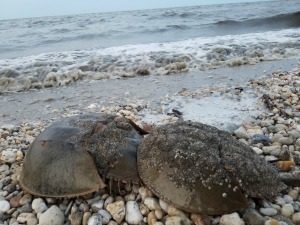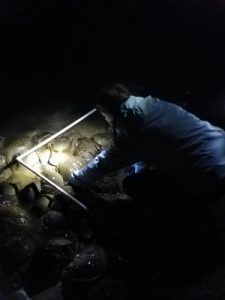
Facebook Twitter Instagram YouTube
Written on: May 30th, 2016 in Wetland Animals
By Maggie Pletta, DNREC’s Delaware National Estuarine Research Reserve
The Delaware Bay is home to the largest population of horseshoe crabs in the world, which is just one of the many reasons the Delaware Bay is so special. The horseshoe crab has been around since before the dinosaurs and is an important animal to the ecosystem and to humans. Their blood is used in the production of LAL (Limulus Amebocyte Lysate) for testing the sterility of medical equipment; their eggs are the food that ensures migratory shorebirds can reach their destinations; and the crabs themselves are part of a thriving commercial fishery. However, since there are so many uses and needs of this extraordinary animal it is important that their numbers are tracked and managed.


To do this every year hundreds of volunteers assist organizations like the Delaware National Estuarine Research Reserve (DNERR) to complete surveys of spawning crabs on Delaware Bay beaches every May and June during the full and new moons. During those moon phases the bay experiences the highest high tides, which is when the horseshoe crab comes up from its watery habitat to leave small green eggs in the wet sand. The volunteers head out on these nights, no matter how late, and walk a one kilometer distance on the beach stopping every 20 meters to count crabs. To ensure the volunteers are counting crabs in a standard size area, one meter by one meter square, they use a quadrat that they lay down on top of the crab line. Once the quadrat is down the volunteers count the number of male and female crabs, and then they pick up the quadrat and head down the beach to their next site. In all, one hundred samples are taken every night on every beach surveyed.
Once the data is collected for the season it is sent to Limulus Laboratories in New Jersey where the data is analyzed and compiled into an annual population report. This report is important because it is what resource managers use to set the harvesting regulations on the horseshoe crab in the Delaware Bay. And the volunteers are the key to a successful survey because without them we would never have enough people to complete the survey and collect this valuable data.